#sydney white (2007)
Text
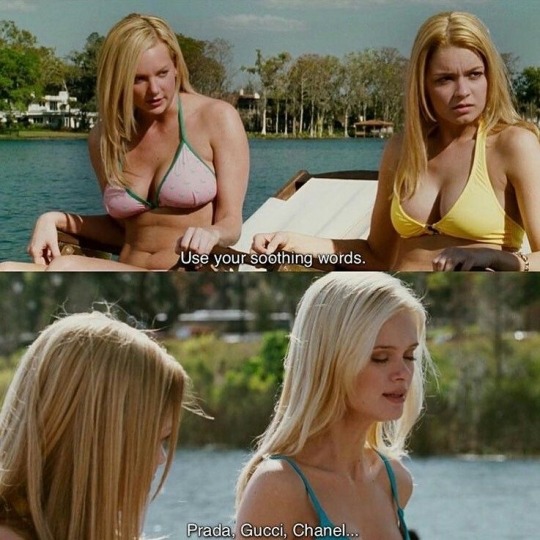
Syndey White (2007) ✨
#sydney white#2007#sara paxton#celebrities#iconic#pop culture#hollywood#fashion#movies#2000s#2000s nostalgia#2000s aesthetic#2000s cinema#2000s style#2000s fashion#late 2000s#2000s movies#2000s music#2000s scene#2000s core#2000s internet#00s#00s movies
19 notes
·
View notes
Text

Sydney White (2007)
25 notes
·
View notes
Text
HELLO I JUST FOUND OUT THAT MATT LONG WAS IN A MODERN SNOW WHITE ADAPTATION?!?? WITH AMANDA BYNES?!?
OMFG HE’S SO YOUNG😧

#sydney white#sydney white (2007)#matt long#manifest nbc#manifest netflix#nbc manifest#manifest on netflix#original post#netflix manifest#the time stamp for it is 18:15
11 notes
·
View notes
Text
Reply to @girlfictions:

1. I didn’t skirt it, that why the definition of Zionism was the very first thing in my post. Now, if you choose to reject that definition and want the word to mean whatever you want it to mean that’s on you. If you think the mere existence of Israel as a country is evil and a bad thing to support, then there’s no productive conversation to be had with you anyway.
2.
Hamas leader's son who became a spy explains what Hamas really wants

What is Gaza’s Ministry of Health and how does it calculate the war’s death toll?



Amnesty International Report, 2015
Tunnel shaft inside Shifa
Article from 2014
Hamas’ rules for social media activists, from 2014
Wounded man at Gaza hospital criticizes Hamas for hiding among civilians
Bodies of two hostages found near Al Shifa Hospital
Body of a third hostage, a Tanzanian agricultural intern, found, although not mentioned where

The second Israel declared independence, 5 Arab countries declared war against them and they won.
List of expulsions and exoduses of Jews
Iraq expelled Jews to Israel
Why there are so many Palestinian refugees

The point here is not "Israel is a saint country that never does wrong". The point is that Israel is not better or worse than any other country or territory. If a Palestinian or someone with connections to Palestine is allowed to love it in spite of what Hamas and other terrorist groups have done and are currently doing without being demonized, cancelled or called evil; then it's only natural to concede that someone from Israel or with connections to Israel is allowed to love it in spite of what its government has done or does currently without being demonized, cancelled or called evil. Especially after Israel suffered a terrorist attack and is receiving antisemitism all over the world.

PBS article from 2007 summarizing Hamas and/vs Fatah, including Hamas’ objectives
Hamas and PIJ use of suicide bombings
Hamas spokesperson says tunnels are to protect the fighters and civilians are the responsibility of the UN and Israel
youtube
UNRWA Education: Textbooks and Terror
Review of 2022 UNRWA-Produced Study Materials in the Palestinian Territories
Hamas Original Charter. Excerpt:
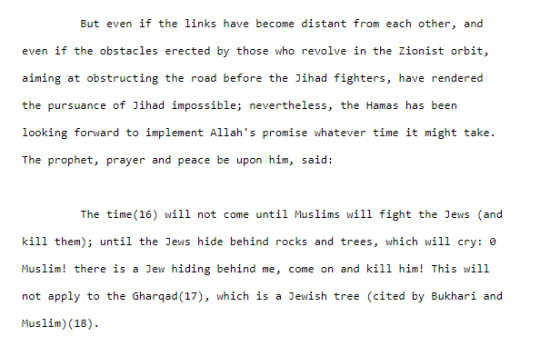

Student speaker at a UPenn rally, the university Noah attends
Pro-Palestine Rally in Sydney, Australia ("Death to Israel", "Intifada", "Gas the Jews")
Rash of international antisemitism carries chilling historical hallmarks
Antisemitic mob storms through Russian airport as flight from Tel Aviv lands
Suspect arrested in death of Jewish protester in Southern California
Pro-Palestine group gives out NYC map calling for 'direct action' on landmarks as city blasts 'hateful rhetoric' and alerts the NYPD

Are you implying that I'm a nonce? Because shipping two fictional characters is not being a nonce. You know what is noncey?
Threatening someone to release CP of them.

Reply right before yours:
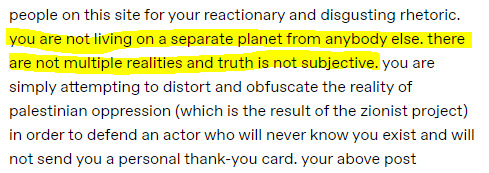
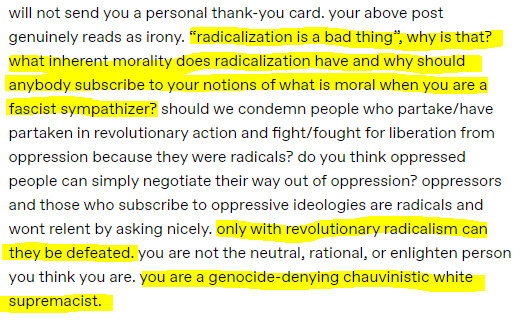
made by someone whose first post was said reply, and only has posts reblogging other people's takes re: Noah, Israel, Palestine
They blasted me for saying we live in different realities, then proceeds to praise radicalism and call me a white supremacist.
Exploring hate: How antisemitism fuels white nationalism
The response that worried me (I don't know or care about the ethnicity or religion of this person).

Glorification of terrorism, dehumanization of the other, refusal to listen to other points of view, inappropriate anger. All of these are signs of radicalization.
Said person reblogged this:

A letter from Osama Bin Laden went viral on TikTok, with many users of every ethnicity and religion praising it. The letter contains several antisemitic tropes, condems homosexuality and of course, idealizes Sharia Law.
youtube
Rolling Stone article on it
#noah schnapp#antisemitism#jumblr#radicalization#extremism#i couldn't care less about noah schnapp knowing i exist#but one day someone will get ideas from this wretched hellsite and try to decolonize a bus full of people or something#and at least i will be able to sleep at night#because with my insignificant voice from my tiny dustspeck of a corner of the internet#i tried to warn y'all#Youtube
33 notes
·
View notes
Text
The Cutty Sark
She was built in Dumbarton (Scotland) on the River Leven at the Scott & Linton shipyard for the London shipowner John Willis as a tea clipper (the last of her kind) and was launched on 25 November 1869. Her motto on the bow: "Where there's a Willis a way - Where there's a will is a way" - a pun on the name of the shipowner Willis, who always wore a tall white top hat. Scott & Linton, who had agreed a price of £16,500 for the ship, had to declare bankruptcy at the end of the construction period - the Cutty Sark was their only large ship ever built. The shipyard William Denny and Brothers completed the construction.
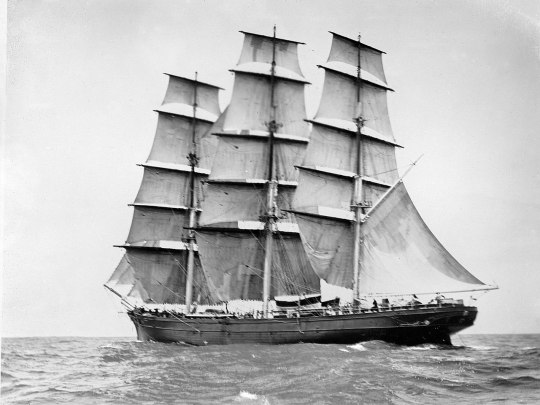
Cutty Sark photographed at sea by Captain Woodget using a camera balanced on two of the ship's boats lashed together, before 1916 (x)
Initially, the clipper was used in tea transport until 1877. The ship never won any of the famous tea races, partly because of the prudence of her captains G. Moodie and F. W. Moore. After the opening of the Suez Canal (17 November 1869), tea transport was taken over by steamships, which made the sea route from Shanghai through the Suez Canal to England in 42 days, while the Cutty Sark needed 102 days for the journey around the Cape of Good Hope.

Sail Plan for 'Cutty Sark' (1869), G. F. Campbell
Later she sailed as a tramp steamer with various cargoes. After a hard time between 1877 and 1882, the Cutty Sark became the fastest sailing ship of her size and time with wool cargoes around Cape Horn in 1885 under her 7th and longest serving Captain Richard Woodget, setting several records and also beating her old rival Thermopylae.

Cutty Sark in port, East Circular Quay, Sydney, by Allen C. Green, before 1916 (x)
Captain Woodget first had the spars and mainmast shortened around the skystay and also removed all the leeward sails that were not needed for the voyages in the Roaring Forties, which made it possible to reduce the crew from 28 to 20 men. Once he was satisfied with the altered rig, Woodget set off with the ship on his first voyage to Australia, running the ship for ten years and making her famous.
Sold in 1895 for £2100 to the Portuguese shipping company "J. A. Ferreira & Companhia" and renamed Ferreira, she was re-rigged as a barquentine after de-rigging in 1916 near the Cape of Good Hope for cost reasons.

The restored ship in her glass dock (x)
In 1922, she was sold to the Companhia Nacional de Navigação and renamed Maria do Amparo. In the same year, the desolate ship, coming from a repair stop in London, entered the port of Falmouth due to a storm. Retired Captain Wilfred Dowman recognised the 53-year-old ship, which he had always held in high esteem as a ship's boy, and bought her from the Portuguese owner in Lisbon for £3,750, brought her to Falmouth and restored her to her original condition with the assistance of his wife, who shared his enthusiasm for the beautiful vessel.

Cutty Sark as training ship, by Jack Spurling (x)
She served in Falmouth as a stationary training ship until 1938. In 1938, the Cutty Sark came to the Thames Nautical Training College in Greenhithe (until 1949) as a gift from Captain Dowman's widow. In 1954, the famous ship was transferred on her last sea voyage to the purpose-built dry dock in Greenwich, where she has been accessible as a museum ship since 1957.
In early October 2006, the ship was closed for extensive restoration work and was due to reopen in 2009. On 21 May 2007, a fire occurred, presumably caused by a defective hoover, which burnt out most of the hull.

The Cutty Sark after the fire 2007 (x)
Fortunately, about half of the ship's equipment - for example, the masts and steering wheel - had been removed from storage at the time because of the work, and 19th century teak (worth £400,000) provided for restoration purposes had not yet been installed. Nor was the steel skeleton completely destroyed by the fire. Thanks to these circumstances, her complete restoration was possible; the ship was reopened on 25 April 2012 in the presence of Queen Elizabeth II and Prince Philip. On 18 October 2014, the ship was damaged by a fire on deck and was also restored. Since then, she can be visited again in her usual dock.
#naval history#ships who made history#cutty sark#tea and wool clipper#late 19th century -today#age of steam#modern times
192 notes
·
View notes
Text
✦Who I Write For✦
Rules
(This will be added too over time)
SLASHERS
⭑Bo Sinclair
⭑Vincent Sinclair
⭑Lester Sinclair
⭑Michael Myers (OG, 2007, & Gramps)
⭑Thomas Hewitt
⭑Bubba Sawyer
⭑Jason Voorhees
⭑Ghostface (Billy & Stu)
⭑Tiffany Valentine
⭑Brahms Heelshire
⭑Billy Lenz
⭑Carrie White
⭑Baby Driftwood
⭑Otis Driftwood
⭑Pyramid Head
⭑Herbert West (if a male/masc reader)
-Bonus-
⭑Carly & Nick; House of Wax
⭑Sydney; Scream
Dead By Daylight
♢Evan MacMillan - The Trapper
♢Anna - The Huntress
♢Max Thompson Jr. - The Hillbilly
♢Sally Smithson - The Nurse
♢Herman Carter - The Doctor
♢Ji Woon Hak - The Trickster
♢Danny Johnson - The Ghostface
♢Philip Ojomo - The Wraith
♢Amanda Young - The Pig
♢Rin Yamaoka - The Spirit (only SFW)
♢Kazan Yamaoka - The Oni
♢Frank Morrison - The Legion
♢Susie Lavoie - The Legion (only SFW)
♢Julie Kostenko - The Legion
♢Joey - The Legion
♢Adiris - The Plague
♢Caleb Quinn - The Deathslinger
♢Carmina Mora - The Artist
♢Sadako Yamamura - The Onryo (only SFW)
♢Tarhos Kovacs - The Knight
♢Adriana Imai - The Skullmerchant
♢Nemesis - The Nemesis
-Bonus-
♢Jill Valentine
♢Leon Kennedy
♢Cheryl Mason
♢Carlos Oliveria
♢Claudette Morel
♢Bill Overbeck
♢Vittorio Toscano
Our Life; Beginnings & Always
❧Cove Holden
❧Derek Suarez
❧Baxter Ward
❧Elizabeth Last (x readers for non-sibling characters)
❧Kyra Preece
❧Tamarack Baumann
❧Qui "Autumn" Lin
Beetlejuice
⚂Lawrence Beetlegeuse Shoggoth
⚂Lydia Deetz (only SFW)
⚂Adam Maitland
⚂Barbara Maitland
⚂Ms.Argentina
Call of Duty; Modern Warfare
✚Simon "Ghost" Riley
✚Johnny "Soap" MacTavish
✚John Price
✚Kyle "Gaz" Garrick
✚Alejandro Vargas
✚Rodolfo "Rudy" Parra
✚Valeria Garza
✚Alex Keller
✚Farah Karim
✚Nikolai
✚Konig
✚Horangi
Random
❦Eddie Brock & Venom (2015)
❦Frankenstein's Monster - Mary SHelly
❦Classic Monsters; Dracula, Werewolves, etc.
❦Krampus(yes you read me)
❦Y/N from Stuck on A Childhood Crush/Friend & Killer (aka Cordelia)
Yes that's write. You can have your Y/N x Reader fics now.
33 notes
·
View notes
Text
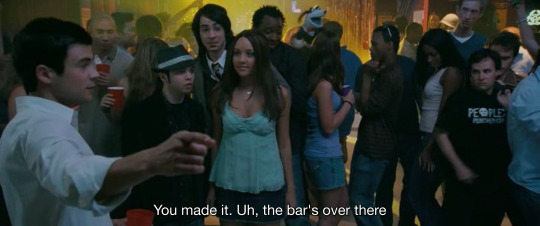
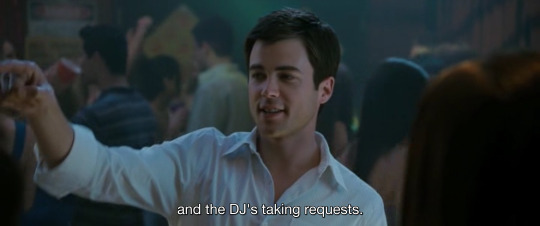

Sydney White (2007) dir. Joe Nussbaum
#Sydney White#2000s#movie#Сидни Уайт#Amanda Bynes#Sara Paxton#Matt Long#Jack Carpenter#Jeremy Howard#Crystal Hunt#Adam Hendershott#Danny Strong#Samm Levine#Arnie Pantoja
62 notes
·
View notes
Text
2012 Lover Diaries Transcripts
Feb 2012
Holy Ground Lyrics
Mar 2, 2012- Perth, Australia
So here we are in Perth. It’s a beach town on the Indian Ocean and it’s beautiful. It’s 85º and sunny and yesterday I went to Cottesloe Beach – I’ve never seen water that crystal blue before. And white sand. There was this art festival going on, so there were all these sculptures set up on the beach. We laid our towels out and got tans and frolicked in the water. After our beach afternoon, we went to this restaurant right on the beach called Indiana. It was built in 1910 and looked like an old fancy hotel. It’s one of the most beautiful places I’ve been, with old world arches and moldings, antique tables and big french doors opening out to views of azure blue ocean. We sat there for hours drinking strawberry mojitos and eating calamari until I was so tired, I went back to my fluffy hotel bed and slept.
I’ve been thinking a lot about getting older and relevancy and how all my heroes have ended up alone. I wrote a song on the plane ride from Sydney to Perth on the appalachian dulcimer I bought the day of my flight. I bought it because Joni played on most of her blue record. I taught myself to play ‘A Case of You.’ Anyway, I wrote a song on it called “Nothin New” and it’s about being scared of aging and things changing and losing what you have. It says “I’m getting older and less sure of what you like about me anyway.” And in the chorus it says “How can a person know everything at 18, and nothing at 22? And will you still want me … when I’m nothing new.” It’s a really vulnerable song, but I think it’s important to say.
Jun 10, 2012- Los Angeles, CA
I’ve been in the studio non stop. This week I was in with Max Martin and Johan Shellback, the guys I wrote ‘Getting Back Together’ with. The first day, I had to do this corporate performance for an arena full of managers. I played Love Story and Mean, solo acoustic and Justin Timberlake was MCing so he introduced me. Hilarious sense of humor. He was making the whole arena laugh.
When I finished there, I got on the plane and this idea came to me “I don’t know about you, but I’m feeling 22.” I wrote the entire chorus on the plane ride to LA. When I landed, I went straight to the studio and played it for Max and Johan. They loved it.
I was so excited. I wrote 22 about how much fun I’ve been having this summer and this year in general. It’s so carefree and sounds like a summer anthem. I was floating on a cloud after we wrote it. The next day I brought them a chorus called 'Trouble’ that’s about how I should’ve known what I was getting into.
We came back to 'Trouble’ and it turned out to be absolutely amazing. It’s so edgy and unexpected. It’s almost dub step. My friends love that one the most.
I love writing so much. It’s the only thing that makes total sense to me. If I missed a day in the studio, I’d be so mad at myself. God I’ve been having such a beautiful life lately. I can’t believe it. It’s like there’s magic in the air.
Friday was my day off. I woke up and went hiking. Then went home and showered. painted my nails, daydreamed about our trip for 4th of July.
Taylor
Oct 17, 2012- Los Angeles, CA
This Love lyrics
(2003 • 2004 • 2005 • 2006 • 2007 & 2008 • 2009 • 2010 • 2011 • 2012 • 2013 • 2014 • 2015 • 2016 & 2017)
#lover diaries*#note: dates and place names are from my notation not taylors#and i didnt transcribe the specific lyrics bc the formatting was giving me a headache#so go to taylorpictures.net if you want those
9 notes
·
View notes
Text
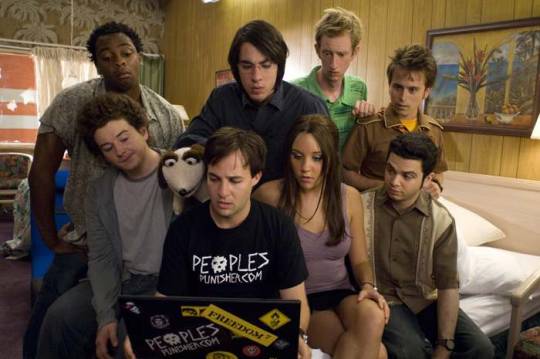

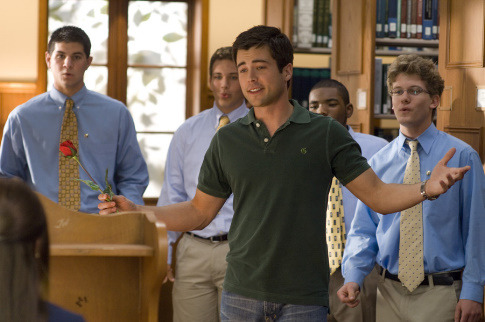

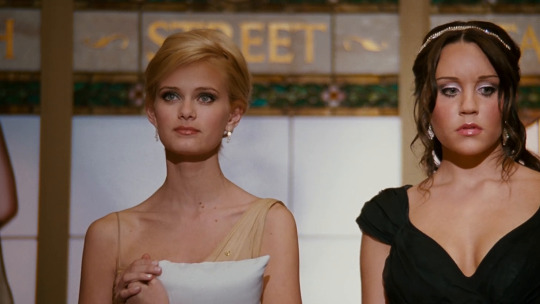

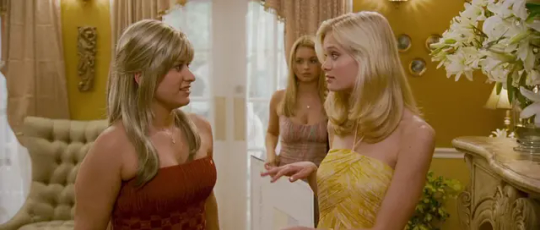



Sydney White
2007
#sydney white#amanda bynes#matt long#sara paxton#jack carpenter#jaremy howard#danny strong#samm levine#crystal hunt
4 notes
·
View notes
Note
Have you seen Sydney White (2007) I think you’d really like it and it could make a cool smau idea if you’re interested
Omg I have seen this! It’s like a modern adaptation of Snow White, right? Really cute. However I am working on actually another reimagined Amanda Byrnes movie smau. Maybe another time ☺️
3 notes
·
View notes
Text
Events 2.13 (after 1940)
1945 – World War II: The siege of Budapest concludes with the unconditional surrender of German and Hungarian forces to the Red Army.
1945 – World War II: Royal Air Force bombers are dispatched to Dresden, Germany to attack the city with a massive aerial bombardment.
1951 – Korean War: Battle of Chipyong-ni, which represented the "high-water mark" of the Chinese incursion into South Korea, commences.
1954 – Frank Selvy becomes the only NCAA Division I basketball player ever to score 100 points in a single game.
1955 – Israel obtains four of the seven Dead Sea Scrolls.
1955 – Twenty-nine people are killed when Sabena Flight 503 crashes into Monte Terminillo near Rieti, Italy.
1960 – With the success of a nuclear test codenamed "Gerboise Bleue", France becomes the fourth country to possess nuclear weapons.
1960 – Black college students stage the first of the Nashville sit-ins at three lunch counters in Nashville, Tennessee.
1961 – An allegedly 500,000-year-old rock is discovered near Olancha, California, US, that appears to anachronistically encase a spark plug.
1967 – American researchers discover the Madrid Codices by Leonardo da Vinci in the National Library of Spain.
1975 – Fire at One World Trade Center (North Tower) of the World Trade Center in New York.
1978 – Hilton bombing: A bomb explodes in a refuse truck outside the Hilton Hotel in Sydney, Australia, killing two refuse collectors and a policeman.
1979 – An intense windstorm strikes western Washington and sinks a 0.5-mile (0.80 km) long section of the Hood Canal Bridge.
1981 – A series of sewer explosions destroys more than two miles of streets in Louisville, Kentucky.
1983 – A cinema fire in Turin, Italy, kills 64 people.
1984 – Konstantin Chernenko succeeds the late Yuri Andropov as general secretary of the Communist Party of the Soviet Union.
1990 – German reunification: An agreement is reached on a two-stage plan to reunite Germany.
1991 – Gulf War: Two laser-guided "smart bombs" destroy the Amiriyah shelter in Baghdad. Allied forces said the bunker was being used as a military communications outpost, but over 400 Iraqi civilians inside were killed.
1996 – The Nepalese Civil War is initiated in the Kingdom of Nepal by the Communist Party of Nepal (Maoist-Centre).
2001 – An earthquake measuring 7.6 on the Richter magnitude scale hits El Salvador, killing at least 944.
2004 – The Harvard–Smithsonian Center for Astrophysics announces the discovery of the universe's largest known diamond, white dwarf star BPM 37093. Astronomers named this star "Lucy" after The Beatles' song "Lucy in the Sky with Diamonds".
2007 – Taiwan opposition leader Ma Ying-jeou resigns as the chairman of the Kuomintang party after being indicted on charges of embezzlement during his tenure as the mayor of Taipei; Ma also announces his candidacy for the 2008 presidential election.
2008 – Australian Prime Minister Kevin Rudd makes a historic apology to the Indigenous Australians and the Stolen Generations.
2010 – A bomb explodes in the city of Pune, Maharashtra, India, killing 17 and injuring 60 more.
2011 – For the first time in more than 100 years the Umatilla, an American Indian tribe, are able to hunt and harvest a bison just outside Yellowstone National Park, restoring a centuries-old tradition guaranteed by a treaty signed in 1855.
2012 – The European Space Agency (ESA) conducted the first launch of the European Vega rocket from Europe's spaceport in Kourou, French Guiana.
2017 – Kim Jong-nam, brother of North Korean dictator Kim Jong-un, is assassinated at Kuala Lumpur International Airport.
2021 – Former U.S. President Donald Trump is acquitted in his second impeachment trial.
2021 – A major winter storm causes blackouts and kills at least 82 people in Texas and northern Mexico.
2 notes
·
View notes
Text
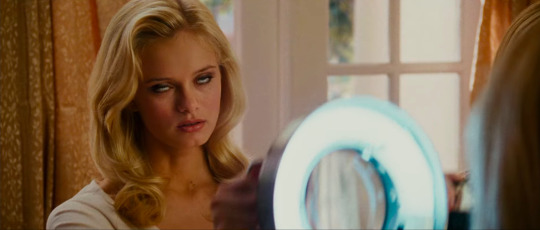
Sydney White (2007)
23 notes
·
View notes
Text
By: Rav Arora
Published: Dec 22, 2020
We are frequently told by commentators and theorists on the progressive and liberal Left that we live in a systemically racist and patriarchal society. The belief that Western societies privilege white men and oppress people of color, women, and LGBT citizens is especially popular within academic institutions, legacy media, the entertainment industry, and even sports. However, newly released statistics from the US Department of Labor for the third quarter of 2020 undermine this narrative. Asian women have now surpassed white men in weekly earnings. That trend has been consistent throughout this past year—an unprecedented outcome. Full-time working Asian women earned $1,224 in median weekly earnings in the third quarter of this year compared to $1,122 earned by their white male counterparts. Furthermore, the income gap between both black and Latino men and Asian women is wider than it has ever been. The income gap between white and black women, meanwhile, is much narrower than the gap between their male counterparts.
These outcomes cannot exist in a society suffused with misogyny and racism. As confounding to conventional progressive wisdom as these new figures appear to be, copious research finds that ethnic minorities and women frequently eclipse their white and male counterparts, even when these identities intersect. Several ethnic minority groups consistently out-perform whites in a variety of categories—higher test scores, lower incarceration rates, and longer life expectancies. According to the latest data from the US Census Bureau, over the 12 months covered by the survey, the median household incomes of Syrian Americans ($74,047), Korean Americans ($76,674), Indonesian Americans ($93,501), Taiwanese Americans ($102,405), and Filipino Americans ($100,273) are all significantly higher than that of whites ($69,823). The report also finds substantial economic gains among minority groups. Valerie Wilson at the Economic Policy Institute reports that from 2018 to 2019, Asian and black households had the highest rate of median income growth (10.6 percent and 8.5 percent, respectively) of all main racial groups (although she cautions that overall disparities remain “largely unchanged”). On a longitudinal scale, Hispanics, not whites, had the highest income growth in 2019 relative to the start of the Great Recession in 2007 (although many of these gains have been reversed by the pandemic).
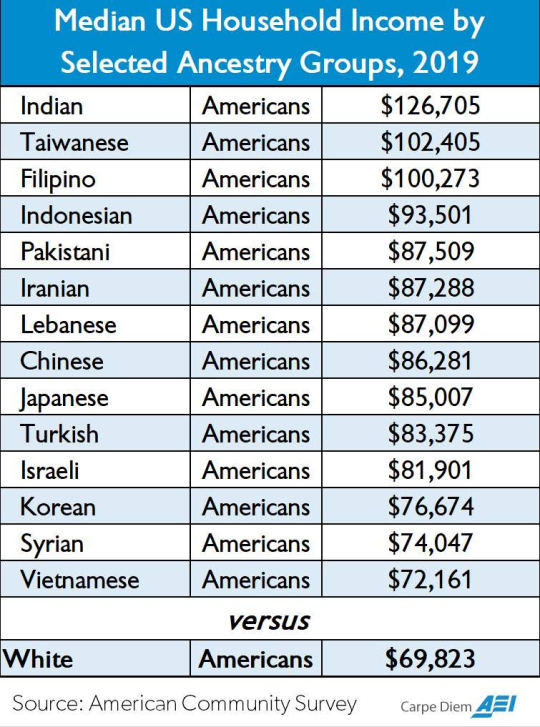
Rapidly rising female economic success is partly a product of higher academic representation. 2019 was the 11th consecutive year in which women earned the majority of doctoral degrees. Women accounted for 57 percent of all students across American colleges in 2018 according to the latest US Department of Education figures and earned the majority of associate’s, bachelor’s, and master’s degrees. According to University of Michigan economist Mark J. Perry, “By overall enrollment in higher education men have been an under-represented minority for the last 40 years.” Sex differences in cognition can help to explain differential performance along gender lines—although men typically perform better on quantitative and visuospatial tasks, several studies have found that on average women perform better in verbal and memory tasks and on reading and writing tests. According to the Organization of Economic Cooperation and Development:
At the primary level, boys and girls do equally well in mathematics and science but girls have a clear advantage in reading (OECD, 2012a). At the secondary level while girls maintain their advantage in reading a gap in favour of boys emerges in mathematics… [T]he gender gap in reading is much larger than the gap in mathematics. On average, the reading gap was equal to 38 points in PISA 2012, which roughly equals one year of schooling. The gap in mathematics was nine points on average.
These disparities can be explained by several factors. Studies have found that girls are more self-disciplined and better at listening, whereas boys tend to be more rebellious, more aggressive and, contrary to popular wisdom, more socially exclusionary in school. Research has also found that girls mature in certain cognitive and emotional areas faster than boys, with girls’ brains developing up to two years earlier during puberty which can give them an academic performance advantage in school.
* * *
The specious concept of intersectionality underpins the oppression narratives advanced by contemporary progressive activists. Its advocates hold that class, race, sexual orientation, age, gender, and disability can compound an individual’s oppression or privilege. For example, an ethnic woman not only faces racism and sexism, but also a third intersecting prejudice (known as “misogynoir” in the case of black women) that ethnic men and white women do not experience. So, ethnic women are more oppressed and that oppression is central to their identity and delimits their success in our society.
Apart from the most obvious theoretical flaw of intersectionality—that it flattens the diverse complexity of human experience into a few arbitrary characteristics—its validity falls apart under empirical scrutiny. For example, despite the greater oppression black women supposedly face compared to white women, a much-publicized 2018 study featured in the New York Times found that black women had slightly higher incomes than white women raised in families with comparable earnings. The earnings of black men, on the other hand, were found to be consistently much lower than those of white men from similar economic backgrounds. Controlling for parental earnings, black women were found to have higher college attendance rates than white men.
A study from the University of Michigan compared the earnings trajectories of African immigrant women and men to their US-born counterparts. The (very left-leaning) researchers went into the study with an intersectional analytic framework, stating: “The double disadvantage would predict that black African women would be disadvantaged by the interaction of their race and gender.” But having analyzed the data, the authors concluded: “However, these are not the patterns that we found.” While African-born black men had lower earnings than US-born white men, African-born black women had higher earnings than US-born white women. Interestingly, the researchers found that the income growth rate of female African immigrants has outpaced that of both US-born men and women. Black female immigrants from Africa saw a 130 percent rise in their income between 1990 and 2010, eclipsing the earnings of both white and black American women. No variance of the oversimplified “institutionalized racism” or intersectionality framework can adequately explain these complex socioeconomic outcomes, even when the researchers are biased in that direction.
Intersectionality is such a misconceived lens through which to understand the world that often white men fare worse than some of the most “oppressed” victim groups in our society. For example, the latest Census data indicate that the median earnings for full-time, year-round female Palestinian American workers ($52,061), female Iranian American workers ($64,220), and female Turkish American workers ($67,759) were all higher than those of white women ($45,581). Turkish and Iranian women also out-earned white men ($57,003). The vast majority of these women have not two but three “oppression variables” because of their gender, ethnicity, and religion (Islam).
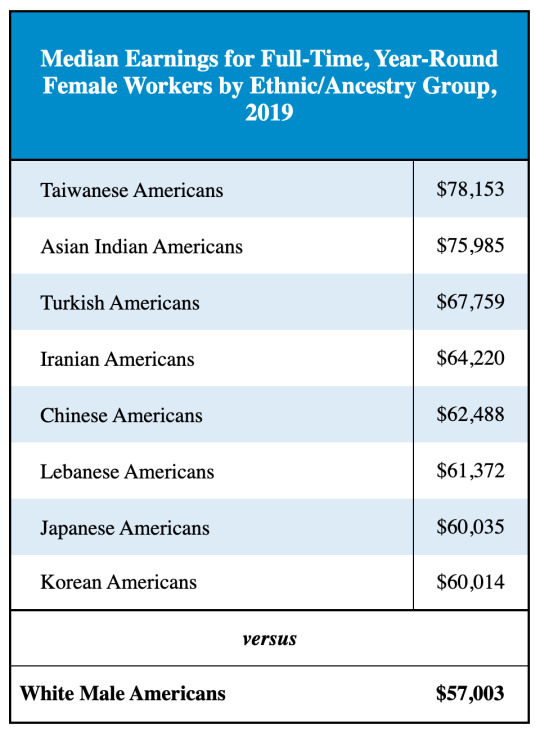
Perceived discrimination is necessarily subjective and a kind of minority bias can skew perception of racial bias. Nevertheless, I don’t doubt that many women of color face discrimination on account of their gender, ethnicity, or religion, or all three. According to a 2017 Pew survey, 83 percent of US Muslim women said there was a lot of discrimination against Muslims and more than half of US Muslim women said they had experienced anti-Muslim discrimination in the past 12 months at the time of the survey. However, if economic outcomes are to be taken seriously, the power of “intersecting” sexism, Islamophobia, and racism does not appear to be a barrier to success or sufficient to suppress human potential. To the contrary, intersectional theory broadly exaggerates the magnitude and impact of prejudice in our society, and gives the illusory impression of a zero-sum societal competition between groups. As Jordan Peterson has argued, intersectionality “devolve[s] people back into tribal antagonism.”
youtube
* * *
Asian success in the West has long been disputed as an example of the “model minority myth” that critics say is used to downplay the impact of societal racism. Asian immigrants, they argue, come from the highly educated upper echelons of their home countries, which gives them an advantage over native-born citizens. But this claim is self-refuting—it admits that “human capital” (familial values, vocational skills, work ethic, conducive cultural patterns) supersedes perceived discrimination and the impact of any systemic or institutional racism. Immigrants who arrive in a new land to which they are not acculturated, but whose intelligence and cultural habits allow them to outperform native whites over time, repudiate a progressive narrative that insists race and not merit determines success.
While immigration selectivity does factor into relative Asian success, it only accounts for part of the reason certain Asian groups have excelled in the West—immigrant groups are not uniformly educated or economically well-off. For example, about 50 percent of Chinese, Pakistani, Indonesian, Korean, and Filipino immigrants have a bachelor’s degree or higher. But the same is true of only a quarter of Vietnamese immigrants—fewer than white Americans (35 percent in 2016). Syrian immigrants have roughly the same level of education as white Americans, yet Syrian Americans and the rest of these aforementioned groups out-earn whites according to the latest data. This is despite the fact that language barriers disadvantage immigrants relative to native-born Americans. Only 34 percent of Vietnamese immigrants and 51 percent of Japanese immigrants (to take two examples) are proficient in English (compared with virtually all of white Americans), yet they still have higher household median incomes than whites by about $2,000 and $15,000, respectively. The idea that all—or most—immigrants are preconditioned for success is a myth. Selectivity is only one part of the puzzle.
Some immigrant groups with high rates of poverty defy the odds and flourish in the US. For example, the children of immigrants from Southeast Asian countries such as Cambodia, Vietnam, and Laos routinely attain high levels of academic achievement despite their low socioeconomic status compared to whites. In their paper, “Culture and Asian-White Achievement Difference,” University of Michigan sociologists Airan Liu and Yu Xie offer a meta-analysis of the available literature on Asian academic achievement. They find that:
Qualitative research indicates that even Asian American children from disadvantaged family backgrounds enjoy the Asian premium in academic achievement (e.g., Lee and Zhou, 2014), which suggests that access to more and better home resources is not the key to their success.
Several studies that control for self-selecting factors still find that several Asian groups out-perform whites in the economic domain. The most pronounced disparities are among women. In a comprehensive 2019 study conducted in Canada, researchers controlled for age, marital status, education level, and native language to compare yearly incomes between second generation ethnic groups with white Canadians. Interestingly, no second generation male ethnic group out-earned third-plus generation whites (without controlling for the aforementioned variables, South Asian, Japanese, Korean, and Chinese men out-earned third-plus generation whites). The outcomes among women, however, were very different. South Asian, Chinese, Southeast Asian, and Korean immigrant women all out-earned third-plus generation white women. The intersectional claim of overlapping oppression again fails because ethnic women perform relatively better than ethnic men compared to their gendered counterparts.
Asian women’s extraordinarily high earnings can be explained by several recorded cultural patterns. They have the highest education levels of all major groups. They are also most likely to major in the most high-paying fields in college (primarily STEM) compared to other female groups. Asian women’s familial choices also strongly correlate with their success in the labour market. According to the CDC (table 11), Asian mothers are least likely to have children out of wedlock. Only 11.7 percent of Asian children are born out of wedlock, compared to 28.2 percent of whites, 51.8 percent of Hispanics, and 69.4 percent of blacks (it is worth noting, incidentally, that the black illegitimacy rate in 1940 was lower than the white illegitimacy rate today). Moreover, the average age of an Asian mother at the time she gives birth to her first child is just over 30. Comparatively, the average age is 28 for whites and 25 for Hispanics and blacks. Asians also have lower birth rates than blacks and Hispanics (but not whites) and the lowest divorce rate. Japanese, Korean, and Chinese women specifically have lower birth rates than all major racial groups [figure 2 in the linked paper]. And as sociologists Arthur Sakamoto and Sharron Xuanren Wang point out in their new paper, Asian children benefit from familial support:
In addition to being more likely to have their own two biological parents, Asian American children benefit from being more likely to have the supplementary adult supervision of grandparents in their home (Raley et al., 2019), who help to provide quality childcare as well as to instill more traditional Asian values (Tam and Detzner, 1998).
Stating these facts has become controversial due to fears of stereotyping and stigmatizing members of under-performing groups. But regardless of one’s personal views on illegitimacy, marriage, and parenthood, Asian women’s cultural habits on average—majoring in more high-paying fields, rarely having kids out of wedlock, and having fewer kids and more familial support raising them—do correlate with better outcomes: more stable families, financial security, and time devoted to pursuing a career.
But this has become a taboo realm of analysis in a culture preoccupied with society’s structural dynamics because it implicates personal choices and cultural norms in the determination of life outcomes. As Malcolm Gladwell advises in his book Outliers, behavioral traits common in Asian cultures shouldn’t be dismissed—we should learn from them. On average, Asians spend the most amount of time doing homework and the least amount of time watching television compared to other racial groups. Asians are more likely to believe in the idea of self-made success than other major racial groups—a survey by the Pew Research Center found that 69 percent of Asian Americans, compared with 58 percent of the general public, think that “most people who want to get ahead can make it if they are willing to work hard.” In their paper, “Explaining Asian Americans’ Academic Advantage over Whites,” researchers from the University of Michigan and the City University of New York examine Asian Americans’ superior academic achievement. They find that Asian Americans are more likely to believe that self-effort, rather than natural ability, is the main determinant of academic achievement:
These differences matter because students who consider effort important demonstrate greater intrinsic interest in academic tasks and are more likely to interpret challenges as cues to increase effort. The belief that achievement is not predestined but is the result of hard work may motivate Asian-American parents to set high educational expectations for their children.
Their study also finds that “socio-demographic differences explain almost none of the overall Asia-white gap in academic effort,” which means that factors such as household income, marital status, employment, and location have little-to-no bearing on the amount of effort Asian students invest in their education. Interestingly, their study finds South Asian parents have the highest expectations relative to whites (Indian Americans are the highest-earning group in America while Pakistani Americans are fifth). The researchers conclude: “Asian American youth’s advantage in education can be attributed mainly to their work ethic, whether real or perceived, rather than to advantages in cognitive skills or socioeconomic status.”
The cultural phenomenon of Asian overachievement isn’t conditional on genes, intelligence or socioeconomic status. In a study entitled “Race and Economic Opportunity in the United States: an Intergenerational Perspective” led by Raj Chetty from Harvard, the authors found that over 26 percent of Asian children born to parents in the lowest income quintile earn incomes in the highest income quintile compared to 11 percent of whites, seven percent of Hispanics, and three percent of blacks.
It’s no surprise that Asians have the highest economic mobility in America given their shrewd financial sensibilities on average. As Coleman Hughes has pointed out, Asians scored highest in a financial health scorecard (measuring “whether a family is making sound, everyday-financial decisions”) developed by researchers at the Federal Reserve Bank of St. Louis in 2015. Eliminating the confounds of age and education level, their paper finds middle-aged Asian family heads with advanced degrees scored substantially higher on financial health relative to their comparable Hispanic, black, and white counterparts. As such, the authors conclude that “differences in the age composition and in the level of educational attainment across groups explain relatively little of the gaps.” It is culture—at least in significant part—that differentiates why some groups out-perform others.
* * *
The claim that America remains a deeply patriarchal society largely rests on remaining gender disparities. The existence of a “gender wage gap,” for instance, is supposedly supported by the claim that “women make $0.77 for every dollar men make.” But women do not make 77 cents to the dollar of what a man makes doing the same work. Women (on average) earn 77 percent of what men earn in different careers, working fewer hours with less overtime. When one accounts for the disparity in the number of hours worked, the level of occupation, career choices, seniority, length of time in the workplace, and various other factors, the “gender wage gap” all but vanishes.
Female under-representation in STEM fields, for instance, is commonly accepted as evidence of sexism by feminist activists, yet those same activists turn a blind eye to male under-representation in the Arts and the Humanities. Likewise, black under-representation in STEM is offered as unequivocal evidence of systemic bias. This summer, the disparity prompted the #shutdownSTEM hashtag in the aftermath of George Floyd’s death. However, as I wrote in City Journal recently, black over-representation in the music industry, professional sports, and even law enforcement are excluded from the conversation, disfiguring the overall picture.
One frequently hears that economic inequality between whites and blacks is ipso facto evidence of systemic racism. According to the 2019 Census figures, the black-white income gap is indeed large: the median household income of black Americans ($43,862) is only 63 percent that of whites ($69,823). This wide disparity can be demoralizing and provoke denunciation of the systems which would allow this level of inequality to pass. However, these same systems permit all kinds of other inequality as well. The same Census data finds that white Americans earn only 55 cents for every Indian American dollar (median household income $126,705). Yet, one will struggle to find think-pieces about “Indian supremacy” or “anti-white oppression” in Vox.com or Slate.
Full-time, year-round white male workers, specifically, earn 73 cents for every dollar ($57,003) an equivalent Taiwanese American woman makes ($78,153). A cursory glance at the data reveals disparities of this magnitude across the board, some of which are even more significant. When discrimination is (roughly) held constant, disparities persist. For example, the median household income of Iraqi Americans in 2019 ($49,315) was only 66 percent that of Syrian Americans ($74,047), but it would be difficult to argue that Syrians face less prejudice in the United States than Iraqis do. It is more likely that inter-group cultural and behavioral differences account for this disparity as opposed to external, systemic factors.
* * *
Needless to say, biases against women and people of color persist. Multiple studies find that people more readily associate men with high levels of intelligence than women. Even though minority applicants benefit from affirmative action programs implemented in top universities, law firms, tech companies, and banks, some level of racial discrimination in the labour market is still a reality. During the COVID-19 pandemic, hate crimes against Asians of all origins spiked across the West (in Canada, the UK, and the US). I can attest to the degrading impact of racism, xenophobia, and religious persecution in my childhood as I’ve written previously here and here. And on a structural level, underfunded and mismanaged schools in the inner-city, sky-rocketing homicide rates, and the consequential economic divestment all limit the human potential in minority communities.
But the cascading complexity of racial disparities in America undermines the simplistic progressive conviction that America is a systemically racist and patriarchal society—a notion that has become a kind of religious dogma. Instead of striving for true inclusivity, a Manichean divide has now been contrived between whites and “people of color,” women and men, heterosexuals and the LGBTQ community. No amount of empirical evidence can alter the unfalsifiable hypothesis of endemic Western racism and misogyny.
If Western societies are compared to a theoretical equalitarian utopia in which prejudice doesn’t exist, then, yes, they remain racist and misogynistic. But compared to the rest of the planet, Western societies are the freest and most inclusive today. According to a study featured in the Washington Post, Western countries such as the US, Australia, and Canada are the most racially tolerant and inclusive. A 2019 ranking from US News & World Report found that countries such as Canada, the US, and the UK ranked in the top 20 most safe, equitable, and free societies for women.
Countries such as Saudi Arabia, Indonesia, Egypt, Rwanda, India, and Egypt, on the other hand, were found to be among the most racially intolerant. Today, slavery continues to exist in countries like China, Uzebekistan, and Bangladesh. According to the Global Slavery Index, there are over 45 million slaves in the world today. A report released by The Center for Global Policy this week found over half a million Uyghurs are forced to pick cotton.
Mainstream narratives portray white racism as the primary driver of brutality, prejudice, and corruption. But injustices on a far more egregious scale exist throughout the world in the absence of racial diversity (and therefore racial prejudice). For its many flaws, American policing pales in comparison to the scandalous police forces in countries such as Somalia, Honduras, Kenya, and Mexico. Human rights abuses perpetrated by Nigeria’s SARS prompted nationwide protests this fall—though Nigeria is of course a racially (not ethnically) homogenous society.
None of this should be misunderstood as a warrant for complacency—Western societies can and should strive to improve race relations and reduce inequity wherever possible. But nor should we make the perfect the enemy of the good, or mistake progressive free societies for sinister regimes defined by patriarchal oppression and racial bigotry.
#Rav Arora#patriarchy#the patriarchy#racist patriarchy#intersectionality#religion is a mental illness
4 notes
·
View notes
Note
Hi lunette! I just wanted to say I love your wip so far, and I'm excited to see where it goes next. The vibes are already amazing :) Question: How do you separate your story from the original when you're writing retellings?
Hello Sab! :D thank you so much, I'm glad you enjoyed it!! ♡ This is gonna be a slightly lengthy answer, I'm so very sorry, but I tried my best to be articulate and concise :,)
There's mainly two ways most retellings (in my experience) are written; Deconstructing/reconstructing, and borrowing the narrative structure.
Borrowing Narrative Structure
The narrative structure one is a bit simpler and straightforward, so I'll start off with that one! This means that the story is pretty much the exact same as the original, but it's usually put in a different setting/scenario. For example, taking the story of Snow White and setting it in the 1950s, or gender swapping Little Red Riding Hood. The narrative structure is pretty much the same and runs parallel to the original (as in it hits all/most of the same plot beats in chronological order), it's just a "reskin" of the original tale. Personally, I don't enjoy this form as much (both in my own creations and other media), but there are a lot of fun things you can do with it (such as A Cinderella Story replacing Cinderella's shoe with a music playlist on her phone).
Examples of this type of retelling include; Most Disney classics borrow from Grimm, A Cinderella Story (2004), Sydney White (2007), The Lion King (1994), Clueless (1995), The Lunar Chronicles (2012-2015) <- that last one is arguably a slight reconstruction as well, but I'd argue that it generally follows the overall same plot beats of Cinderella, Little Red Riding Hood, Rapunzel and Snow White individually before the stories converge!
Again, I don't usually write these, but these are generally easy to tell apart from the original from an aesthetic and visual standpoint. I will say, if I were to write one of these, I'd want to keep in mind exactly why I'm changing the setting/scenario, and what that change brings to the story. I think that's why A Cinderella Story remains so popular, because while the story is very generic and predictable if you know the original tale, the changes are compelling because the movie ties a seemingly timeless story to a specific time and place, and that brings about organic changes in the story here and there (such as replacing the magical glass slipper with something that exists in its given setting).
Deconstruction and Reconstruction
Deconstruction and reconstruction is probably what most people think of when talking about retellings though, and that's mainly what I enjoy as well! Unlike the previous method that essentially reskins the original structure, this method takes the structure, picks it apart, and puts it back together in new and (ideally) compelling ways. I think Disney's Maleficent is a good example of a reconstruction, because while it does contain the same plot beats of the original (evil fairy visits royal family during the princess' birth, the princess is cursed to prick her finger and fall asleep, she's sent off to live with good fairies and meets a prince, returns home, pricks her finger, falls asleep, awakened by true love's kiss), the entire story is reconstructed in two primary ways; The evil fairy (maleficent) is not the antagonist, and the prince isn't Aurora's true love's kiss. This forces the story to reconstruct itself to fill in those gaps, making Aurora's father the antagonist, and Maleficent becomes Aurora's true love's kiss (also a nice trope subversion, which is often applied to these types of retellings). It deconstructs an important role in the story and an important principle in the story and reconstructs them to retell the same story with slight alterations.
I will also add that some retellings reconstruct the plot/narrative, while others simply reconstruct characters. Some do both!
Examples of this type of retelling include; Maleficent (2014), Snow White and the Huntsman (2012), Heartless (2016), Ever After High (2013), Alice in Wonderland (2010), Ella Enchanted (2004), Frozen (2013), Hoodwinked (2005).
On a last note; I wanna add that these two categories definitely operate on a spectrum! Especially since there really is no such thing as an "original" version when dealing with things like fairytales and folktales, because the written versions are usually based on various oral versions that have changed and developed with time and have regional variations! Plus, some reconstructions can still largely follow the same plot beats! But I find these categories to be an accessible way to distinguish various types of retellings and figuring out where you want to go with your own.
And ALSO! I lied there's technically a third category of retellings that's pretty common where they just switch POVs (like Maleficent kinda does) but these often wind up still leaning more towards deconstruction/reconstruction or borrowing the same narrative, so ^^;
Separating my retelling from the original
Personally, when I want to write a retelling, it's usually because I want to deconstruct the story, pick it apart, and put it back together to see how the elements of the story change and can piece back together in different ways. I enjoy retellings that borrow the same principles of the original, but tell a new story! I think that's why I unironically find Ever After High to be one of the more compelling retellings out there, because it's essentially this huge meta story about how some characters wish to defy the original narrative structure they're presented with, while others want to preserve it, so it's almost like they're the different types of retellings fighting against one another.
I think if you want to make sure that your retelling is different from the original story, you'll want to look at your story consequentially. What happens if the prince isn't Sleeping Beauty's true love's kiss? What happens if the evil fairy starts to care for Sleeping Beauty? What happens if Little Red Riding Hood is the big bad wolf? What happens if you put Little Red Riding Hood in a modern setting, how would that affect the narrative? What happens if you put Cinderella in a realistic setting with no magic, how would that change the glass slipper's role in the story? What's forcing Cinderella to leave at midnight if there's no magic? I think a lot of (particularly YA) retellings fall into the trap of changing things here and there without considering why they're making those changes or how those changes organically impact the story, and that's when a retelling can either feel a bit stale or difficult to distinguish from the original (Disney's Beauty and the Beast 2017 remake is a great example of this). I think a lot of Disney's live action remakes fall into this trap in general (as they are technically adaptations of Disney's retellings of Grimm).
Very sorry for the lengthy answer! I just wanted to make sure that I really explained my process, and I find that picking apart other media/retellings and gauging why I enjoy them and what makes something a compelling retelling is a good way to figure out how I wanna go about writing my own retellings! As long as you borrow the principle elements of a story, you can really do just about anything with them and create something very unique and different that can offer a different perspective of the original (an example being that I've always found the Nutcracker to be a somewhat tragic story, seeing as it's about a man who's been turned into a decorative toy which gives a lot of room to explore one's own humanity and what it means to be human, and that's something I wanted to explore in my own retelling, since that's more or less absent from the original). Figuring out why you enjoy a certain story and expanding upon that or reconstructing the story to highlight that aspect is a great way to take a story and make it your own! I hope this answered your question! And if it didn't, don't be afraid to let me know! ^^;
8 notes
·
View notes
Text
Explained | Snow White live-action remake: Why is Disney classic stirring modern controversy? - Entertainment News
"Zegler's honest, but perhaps ill-advised, remarks on the original film's dated portrayal of gender dynamics and her vision for a more empowered Snow White added fuel to the fire. In an interview last year, she told Extra TV, "The original cartoon came out in 1937, and very evidently so. There’s a big focus on her love story with a guy who literally stalks her. Weird! Weird! So we didn’t do that this time. We have a different approach to what I’m sure a lot of people will assume is a love story just because we cast a guy in the movie. All of Andrew’s scenes could get cut, who knows? It’s Hollywood, baby (Andrew being actor Andrew Jonathan who plays the role of a prince who awakens Snow White with a kiss)."
The response to her comments, let's say, was less than wholesome. Traditionalists yearning for the comforting embrace of nostalgia and seeking a faithful recreation of the animated classic, reviled Zegler, sharing on social media claiming how Zegler is dark-skinned and ugly as compared to the image of Snow White they have in their minds. They will probably continue to complain until the movie comes out. or even after that. Some did celebrate her comments, and the chance to challenge conventions in a new adaption of the classic tale for modern audiences.
The clash between tradition and progress extended to the portrayal of love and feminism. Zegler's assertion that the prince in the original was akin to a "stalker" was met with resistance from those who romanticised everything about the original. Once you become emotionally attached to something or even an idea of that something, reason vanishes. Zegler's declaration that the new Snow White wouldn't rely on the prince for salvation challenged the very idea of the story those traditionalists had in their minds. Thus, Zegler became not Snow White but the Evil Queen for them."
YO, CAN SOMEONE SEND ME SOME BOOTS? I JUST STEPPED INTO A VAT OF BULLSHIT! Below is a list from Wiki of Love Action remakes of Snow White, just in the 2000s. There were over 12 others before then. Two of them from Germany, featuring ONLY the Dwarves. Was the writer of this article counting on short term memory?
7 Dwarves – Men Alone in the Wood (7 Zwerge – Männer allein im Wald) (2004), a German comedy film
The Brothers Grimm (2005), an adventure fantasy film directed by Terry Gilliam and starring Matt Damon, Heath Ledger, and Lena Headey
7 Dwarves: The Forest Is Not Enough (7 Zwerge – Der Wald ist nicht genug) (2006), sequel to the 2004 German film 7 Dwarves – Men Alone in the Wood
Sydney White (2007), a modernization, starring Amanda Bynes
Blancanieves (2012), a silent Spanish film based on the fairy tale.
Mirror Mirror (2012), starring Julia Roberts as the Evil Queen Clementianna,[93] Lily Collins as Snow White, Armie Hammer as Prince Andrew Alcott, and Nathan Lane as Brighton, the Queen's majordomo.
The Huntsman series:
Snow White and the Huntsman (2012), starring Kristen Stewart, Charlize Theron, Chris Hemsworth, and Sam Claflin.
The Huntsman: Winter's War (2016), which features Snow White as a minor character.
How is it that people are throwing so-called fits over live adaptations when some of these others are quite recent and varied in storyline? We're all used to the modern twisting of fairy tales. What some are not used to is being so inartifully and clumsily lectured about male female relationships by an actress who looks about 12 years old. You know what this is about: Interference and ongoing attempted sabotage of the Disney brand.
2 notes
·
View notes
Text
SYDNEY WHITE- 2007 ⭐️⭐️⭐️⭐️

Fun light hearted teen comedy starring Amanda Bynes. Amanda plays Sydney White. She goes to college and joins her mum's (decesased) sorority. Unfortunately, its filled with caniving bimbos and she is betrayed by them. She is forced to join the Vortex house of outcasts and nerds. She befriends them and rallies them together to stand up against the sororities and evil fraternities. Also, the whole things a metaphor for snow white apparently.
This movie was a lot of fun. Now sure theres the occasional joke that isnt funny and makes you go soft instantly, but most of its a good time. Sure, you always know exactly whats going to happen five minutes before it does, but the way things unravelled was quite satisfying.
Amanda Bynes is the star of the show holding everything together. Shes pleasant and likable. This was unfortunately the last lead role of her career and her second last movie altogether coming just before 2010's "Easy A". But its never too late for a comeback.
Also enjoyed Danny Strong as one of her nerd friends. One of the best geeks in the business.
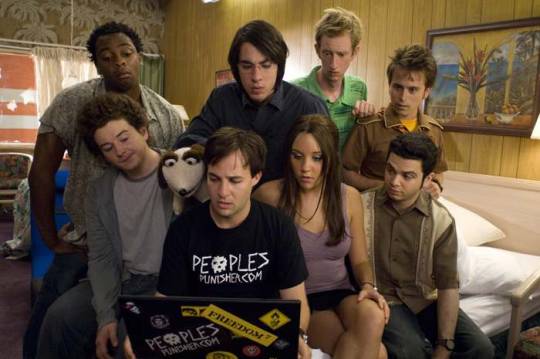
17 notes
·
View notes